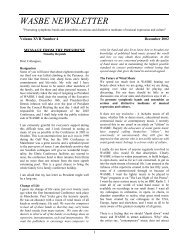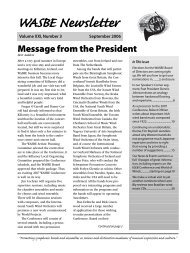March 2011 - World Association for Symphonic Bands and Ensembles
March 2011 - World Association for Symphonic Bands and Ensembles
March 2011 - World Association for Symphonic Bands and Ensembles
You also want an ePaper? Increase the reach of your titles
YUMPU automatically turns print PDFs into web optimized ePapers that Google loves.
Quinquennial State Prize <strong>for</strong> his complete<br />
works in 1964.<br />
During his lifetime, Absil has often been<br />
considered as a pinnacle of modernism as to<br />
his compositions, though he never had as<br />
radical conceptions as Stravinsky or Varèse.<br />
He was no revolutionary <strong>and</strong> was not<br />
inclined to provocation. Contrary to the<br />
group of “The Synthetists” 9 , Absil boasted a<br />
much greater coherence of style. Like Bartók<br />
he showed a great interest in Eastern<br />
European folk music <strong>and</strong> like Stravinsky he<br />
often used irregular <strong>and</strong> asymmetric times,<br />
frequent changes of meters <strong>and</strong> showed an<br />
obvious interest in polyrhythm. Absil<br />
developed a quite personal musical<br />
language, though he never wanted to create<br />
new genres.<br />
On September 8, 1963, the municipality<br />
of Péruwelz 10 wanted to pay homage to the<br />
70 years old Absil. In his vote of thanks at<br />
the official reception, Absil evoked the<br />
weekly concerts on the b<strong>and</strong>st<strong>and</strong> on<br />
Sunday afternoon which had roused up his<br />
interest in Wind B<strong>and</strong> music <strong>and</strong> also praised<br />
the B<strong>and</strong> of the Guides which he qualified as<br />
“prima inter pares” (sic). The concert by the<br />
Royal <strong>Symphonic</strong> B<strong>and</strong> of the Belgian<br />
Guides, conducted by Yvon Ducène,<br />
included the “Flemish Rhapsody”,<br />
“Bulgarian Dances” <strong>and</strong> “Rites”. Five<br />
years later, on September 22, 1968, the<br />
municipality of Péruwelz once more paid a<br />
solemn tribute to Absil on the occasion of his<br />
75 th birthday. The homage included the<br />
unveiling of a statue representing the<br />
composer, sculptured by Fern<strong>and</strong> Debonnaires<br />
11 , <strong>and</strong> closed with a concert in the<br />
local basilica by the Royal <strong>Symphonic</strong> B<strong>and</strong><br />
of the Belgian Guides conducted by Yvon<br />
Ducène. On the occasion of Absil’s 80 th<br />
birthday, a concert, attended by Queen<br />
Fabiola, was organized at the Etterbeek<br />
town hall on October 23, 1973 as a tribute<br />
The Wind B<strong>and</strong> of Bonsecours<br />
to the composer. Some months later, Jean<br />
Absil got a heart attack <strong>and</strong> died at Uccle<br />
(Brussels) on February 2, 1974.<br />
To commemorate the centenary of Absil’s<br />
birth, the <strong>Symphonic</strong> B<strong>and</strong> of the Belgian<br />
Guides, conducted by Norbert Nozy, played<br />
a concert at Péruwelz on October 24, 1993.<br />
The program included “Fantaisie Caprice”,<br />
“Rites”, “Rhapsodie Brésilienne”,<br />
“Rhapsodie Flam<strong>and</strong>e” <strong>and</strong> “Roumaniana”,<br />
besides “Hommage à Jean Absil”<br />
composed by Victor Legley 12 .<br />
The <strong>Symphonic</strong> B<strong>and</strong> played a rather<br />
important role in Absil’s orchestral output,<br />
not only because of his many original Wind<br />
B<strong>and</strong> compositions, but also because he<br />
wrote several transcriptions <strong>for</strong> <strong>Symphonic</strong><br />
B<strong>and</strong> of a number of his own orchestral<br />
pieces.<br />
The original compositions<br />
<strong>for</strong> <strong>Symphonic</strong> B<strong>and</strong><br />
His youth experiences as a member of the<br />
”Royale Fanfare Communale”, the Wind<br />
B<strong>and</strong> of his birthplace, as well as his apprenticeship<br />
with Paul Gilson quite evidently<br />
incited Jean Absil to compose <strong>for</strong> Wind<br />
B<strong>and</strong>. He first tried his h<strong>and</strong> by writing a<br />
b<strong>and</strong> transcription of two of his own compositions,<br />
the Rhapsodie Flam<strong>and</strong>e (Flemish<br />
Rhapsody) <strong>for</strong> orchestra written in 1923 <strong>and</strong><br />
the Suite Pastorale <strong>for</strong> piano composed in<br />
1939. Un<strong>for</strong>tunately, the dates of composition<br />
of the original works have also been<br />
(probably erroneously) attributed to the<br />
transcriptions which we suppose to have<br />
been made later.<br />
RITES OPUS 79<br />
Absil’s very first original composition<br />
conceived <strong>for</strong> <strong>Symphonic</strong> B<strong>and</strong> dates from<br />
1952. The three-part suite Rites opus 79<br />
was right away a real masterpiece. Almost<br />
<strong>for</strong>ty years after the Dionysiaques written<br />
Title page “Rites”<br />
by his friend Florent Schmitt, Absil composed<br />
what could be considered as the<br />
Belgian counterpart of this cornerstone of<br />
French Wind B<strong>and</strong> music. It is probably not<br />
quite by chance that, in exactly the same<br />
manner as Dionysiaques, this composition is<br />
also related to an ancient pagan ritual. The<br />
suite should indeed be interpreted as the<br />
musical evocation of an ancient cult. Those<br />
“rites” suggest the worship of nature deities<br />
<strong>and</strong> express the fear of unknown <strong>and</strong> wicked<br />
<strong>for</strong>ces. The composition consists of three<br />
parts: Part I “Pour saluer l’aurore” (to<br />
welcome dawn) is a description of the<br />
awakening of nature with, among other<br />
things, a tribute to light: Part II “Pour<br />
conjurer les Esprits” (to conjure the ghosts)<br />
describes how the raised spirits appear<br />
massively <strong>and</strong> spread panic until things<br />
finally quiet down again; Part III “Pour fêter<br />
le soleil” (to pay homage to the sun) is a<br />
gr<strong>and</strong> celebration of the sunlight during a<br />
vigorous <strong>and</strong> very rhythmical bacchanal, the<br />
initial theme alternating with the ritual fire<br />
dance. The trilogy Rites was dedicated to<br />
the <strong>Symphonic</strong> B<strong>and</strong> of the Belgian Guides<br />
<strong>and</strong> its then conductor Simon Poulain 13 . It<br />
was premiered at a radio concert broadcast<br />
by the “Institut National de Radio” (I.N.R.)<br />
on December 7, 1952. Due to the rightly<br />
deserved great success of Rites, Absil began<br />
to compose regularly <strong>for</strong> <strong>Symphonic</strong> B<strong>and</strong>.<br />
Both the extremely rich sonorities of the<br />
Wind B<strong>and</strong> <strong>and</strong> the matchless virtuosity of<br />
the <strong>Symphonic</strong> B<strong>and</strong> of the Belgian Guides<br />
encouraged Absil to compose <strong>for</strong> that type<br />
of orchestra.<br />
Instrumentation: piccolo – flute – oboe –<br />
English horn – bassoon – contrabassoon – Eb<br />
clarinet – Bb solo clarinet – 1 st Bb clarinet -<br />
2 nd & 3 rd Bb clarinets - bass clarinet – Bb<br />
soprano saxophone – Eb alto saxophone –<br />
Bb tenor saxophone – Eb baritone saxo-<br />
WASBE <strong>World</strong> 21


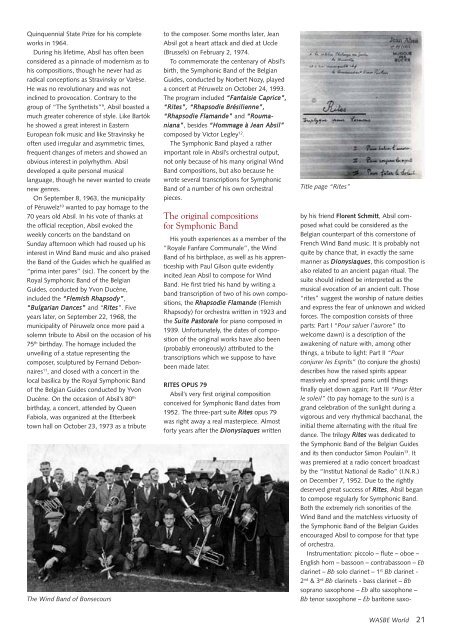
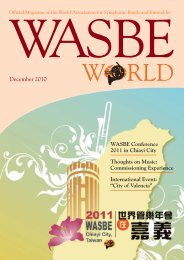
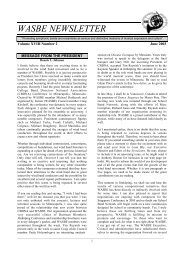

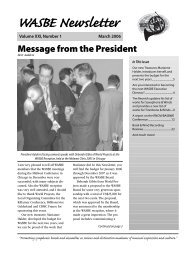
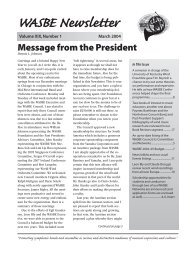

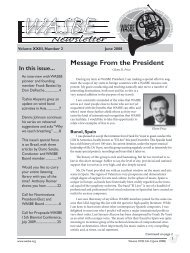
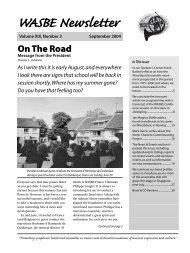
![application form [PDF; 110K]](https://img.yumpu.com/37266203/1/190x253/application-form-pdf-110k.jpg?quality=85)
